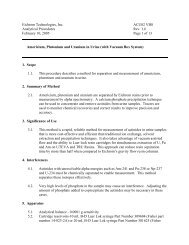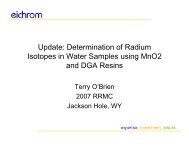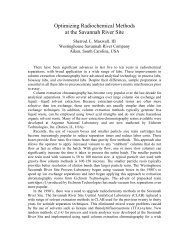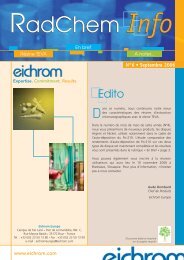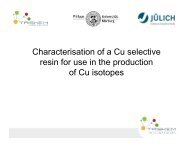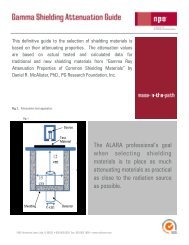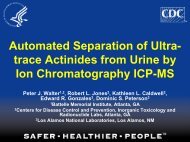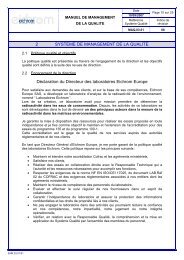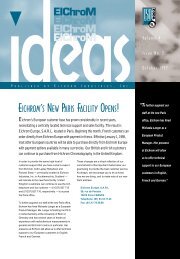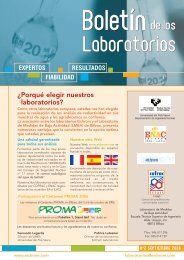Create successful ePaper yourself
Turn your PDF publications into a flip-book with our unique Google optimized e-Paper software.
Procept ® Rapid Dioxin Assay<br />
Kit Insert<br />
expertise.commitment.results.<br />
Contents:<br />
A. Materials Provided/Storage Conditions<br />
B. Additional Materials/Equipment Required<br />
C. Background Inforamation<br />
D. Intended Use<br />
E. Instructions for Use of Kit<br />
F. Performance Characteristics<br />
G. Safety<br />
H. Pipetting Tips<br />
I. References<br />
J. Warranty<br />
K. Procept ® Quick Reference<br />
A. Materials Provided/Storage Conditions<br />
1) 12 Capture Strips (Foil Pouch, Store at Room Temperature)<br />
2) 1-96 plate of glass reaction vials (Store at Room Temperature)<br />
3) Assay Buffer (Store at room temperature for up to a week, refrigerate for longer storage)<br />
4) 25x Wash Buffer (Store at room temperature for up to a week, refrigerate for longer storage)<br />
5) 1 vial of Capture Reagent (Red Cap, Store at -20 o C)<br />
6) 1 vial of Primer/Probe (White Cap, Store at -20 o C)<br />
7) 6 vials of Activation Solution (Clear cap, brown solution, Store at -80 o C)<br />
Note: Activation Solution must be kept at -80 o C until use in a -80 o C freezer, with dry ice or with liquid<br />
nitrogen. Thaw activation solution immediately prior to use. Once thawed, activation solution must be<br />
used or discarded. Thawing and re-freezing activation solution will result in decreased performance of the<br />
assay.<br />
B. Additional Materials and Equipment Required<br />
1) Plate Washer (Biotek Elx50 or equivalent)<br />
2) Plate Shaker (Heidolph Titramax 100 or equivalent)<br />
3) Real-time PCR<br />
4) Calibrated delivery pipets (1-20 µL, 20-200 µL and 100-1000 µL)<br />
5) Barrier pipet tips<br />
6) Optically Clear Adhesive Film (Applied Biosystems no. 4311971)<br />
7) Optical Compression Pads (Applied Biosystems no. 4132639)<br />
8) Deionized water<br />
9) DNA/RNase free water<br />
10) Real-time PCR Master mix<br />
11) 2,3,7,8-Tetrachlorodibenzo-p-dioxin standard<br />
C. Background Information<br />
Polychlorinated dibenzo-p-dioxins and furans (PCDD/F) are a class of environmentally persistent organic<br />
pollutants. Most of the toxic and biological effects of PCDD/Fs have been attributed to interaction with the<br />
aryl-hydrocarbon receptor (AhR), a cytosolic receptor protein found in most vertebrate tissues. The world<br />
health organization (WHO) has assessed the relative toxicity of seventeen PCDD/F congeners (a<br />
www.eichrom.com 11/5/07 page 1 of 7
PCDD/F compound containing a specific number and pattern of chlorine substituents) based on the ability<br />
of the congener to bind to the AhR, elicit AhR-mediated biochemical and toxic responses and be<br />
persistent and accumulate in the food chain. These seventeen PCDD/F congeners have been assigned<br />
toxicity equivalent factors (TEFs) relative to the most toxic congener, 2,3,7,8-tetrachlorodibenzo-p-dioxin.<br />
In standard gas chromatography mass spectrometry (GC-MS) determinations, toxicity equivalent<br />
quotients (TEQ) of PCDD/F containing samples are determined by taking the sum of the concentrations<br />
of each PCDD/F congener multiplied by its TEF.<br />
The PROCEPT ® assay utilizes the affinity of the aryl hydrocarbon receptor for PCDD/F<br />
compounds, forming complexes composed of PCDD/F, the AhR, an aryl hydrocarbon nuclear translocator<br />
protein (ARNT) and a specific DNA response element (DRE). This complex is then bound to a plastic strip<br />
coated with a polyclonal antibody specific for the c-terminus of the ARNT. Excess AhR, ARNT and DNA<br />
are washed away and the amount of DNA is amplified and measured using real-time polymerase chain<br />
reaction (PCR). The output of the PCR instrument is threshold cycle (Ct). The Ct is the number of PCR<br />
temperature cycles at which the measured fluorescence for a given sample/standard exceeds a threshold<br />
value. By comparing the Ct of an unknown sample to the Ct values of a standard curve generated from 5-<br />
7 concentrations of 2,3,7,8-TCDD, the TEQ of the sample can be determined.<br />
The degree of interaction of individual PCDD/F congeners with the AhR is proportional to the TEF<br />
established by the WHO, therefore, the amount of DNA measured by the PCR is proportional to the<br />
PCDD/F TEQ of the sample. However, the PROCEPT ® assay does not provide information on the<br />
amount of each individual PCDD/F congener.<br />
Several other classes of aryl hydrocarbon compounds also interact with the AhR, including<br />
polycyclic aromatic hydrocarbons (PAHs), polychlorinated biphenyls (PCBs) and brominated and mixed<br />
brominated/chlorinated dibenzo-p-dioxins and furans. Therefore, in order to measure PCDD/Fs using the<br />
AhR-PCR assay, a sample preparation method capable of separating PCDD/Fs from other AhR active<br />
compounds is necessary. A complete list of cross-reactivity values and appropriate sample preparation<br />
methods can be found in literature available at www.eichrom.com/dioxin/products.<br />
D. Intended Use<br />
The Procept Rapid Dioxin Assay is an Aryl-hydrocarbon (AhR) based polymerase chain reaction (PCR)<br />
assay for the measurement of polychlorinated dibenzo-p-dioxins and furans (PCDD/Fs) in prepared<br />
sample extracts. Samples should be prepared for measurement by the Procept Assay using an approved<br />
method for isolating PCDD/F from the sample matrix (see methods available from <strong>Eichrom</strong> Technologies<br />
LLC at www.eichrom.com/dioxin/products). Consult the notes listed below in this package insert and<br />
literature available at the <strong>Eichrom</strong> Technologies website for limitations of this method.<br />
Note: The Procept Rapid Dioxin Assay measures total PCDD/F response which correlates with the TEQ<br />
of the sample. The Procept Assay will not provide information on the concentration of individual PCDD/F<br />
congeners present in the sample.<br />
Note: The AhR used in this method binds to PCDD/F and similar molecules based on structure, not mass.<br />
Therefore, 13 Carbon- or other stable isotope labeled standards are detected to the same degree as native<br />
compounds. These labeled standards cannot be used as internal standards with this method.<br />
Note: The Procept Rapid Dioxin Assay is designed for screening of samples according to their TEQ by<br />
responding to PCDD/F congeners in proportion to their concentration and TEF value. However, the<br />
response factors for individual PCDD/F congeners on the AhR-PCR assay are not identical to the TEF<br />
values assigned by the world health organization (WHO). Therefore, variation in the accuracy among<br />
samples may occur solely because of variability in congener composition. Quantitative interpretation of<br />
the data may be possible in certain situations. However, confirmation of positive identification of PCDD/F<br />
contamination and a portion of negative samples by GC-MS is strongly recommended.<br />
E. Instructions for Use of Kit<br />
1. Sample Extraction and Purification<br />
www.eichrom.com 11/5/07 page 2 of 7
Sample extraction and purification techniques will vary with sample matrix. Please consult the<br />
<strong>Eichrom</strong> website (www.eichrom.com/dioxin/products) for appropriate methods for the matrix of<br />
interest.<br />
2. Pre-analysis Preparation<br />
2.1. Preparation of 2,3,7,8-TCDD standards by serial dilution.<br />
2.1.1. The 2,3,7,8-TCDD standard is received as a 5 ug/mL solution in nonane. Prepare<br />
a 200 ng/mL dilution in a 4 mL glass vial by dissolving 80 uL of the standard<br />
in 1920 uL of heptane. Measure volumes using automatic delivery pipets and<br />
barrier pipet tips.<br />
2.1.2. Prepare a 5000 pg/mL dilution in a 4 mL glass vial by dissolving 50 uL of the 200<br />
ng/mL dilution in 1950 uL of heptane.<br />
2.1.3. Prepare a series of 2x serial dilutions of the 5000 pg/mL standard (5000, 2500,<br />
1250, 615, 313, 156 and 78 pg/mL).<br />
2.1.3.1. Label six 4 mL glass vials<br />
a. (2500, 1250, 625, 313, 156 or 78 pg/mL TCDD)<br />
b. Date Prepared<br />
2.1.3.2. Add 1 mL of heptane to each 4 mL glass vial.<br />
2.1.3.3. To the 2500 pg/mL vial, add 1 mL of the 5000 pg/mL standard<br />
using a 100-1000 uL pipet and barrier pipet tip.<br />
2.1.3.4. Seal the 2500 pg/mL vial with a PTFE lined cap a mix thoroughly<br />
using a vortex mixer.<br />
2.1.3.5. Using the 100-1000 uL pipet and a fresh barrier pipet tip, add 1<br />
mL of the 2500 pg/mL standard to the 1250 pg/mL vial. Seal the<br />
vial with a PTFE lined cap and mix thoroughly using a vortex<br />
mixer.<br />
2.1.3.6. Complete the series of 2x serial dilutions as described for the<br />
2500 and 1250 pg/mL standards, using a fresh barrier pipet tip<br />
for each dilution.<br />
2.1.3.7. Prepare an assay blank standard by adding 1 mL of heptane to a<br />
4 mL glass vial.<br />
2.1.3.8. Seal the standard vials securely with PTFE caps and store the<br />
standards out of direct sun light.<br />
3. Sample Analysis<br />
3.1 Preparation of Capture Strips<br />
3.1.1. The wash solution is prepared by diluting 40 mL of the wash solution concentrate to 1<br />
L with deionized water. The wash solution is then placed into a glass flask and used to<br />
prime the plate washer (BioTek ELx50, new buffer prime).<br />
www.eichrom.com 11/5/07 page 3 of 7
3.1.2. The desired number of capture strips are then placed into the orange rack and<br />
washed using the plate washer (3x wash) to remove the protective coating.<br />
3.1.3. The capture reagent is thawed and diluted in a glass test tube with the assay<br />
buffer (40 µL of capture reagent to 600 µL of assay buffer per capture strip).<br />
3.1.4. Using an eight-channel automatic delivery pipette and 100 µL barrier pipette tips,<br />
50 µL of the diluted capture reagent is added to each well of the capture strips.<br />
3.1.5. The capture strips are then placed on the plate shaker (Heidolph Titramax 1000 or<br />
equivalent, speed set at 900) for 60 to 90 minutes.<br />
3.2. Reaction of Samples and Standards with Ah-Receptor (Performed while capture strips are on<br />
the plate shaker)<br />
3.2.1. For each well in the capture strips used, a glass reaction vial is charged with 25 µL of<br />
assay buffer (8-channel automatic delivery pipette and 100 µL barrier pipette tips).<br />
3.2.2. 5-10 µL of the purified sample extract or standard is added to each glass vial (0.1<br />
to 20 µL automatic delivery pipette and barrier pipette tips).<br />
3.2.3. For every two capture strips used, one vial of the activation solution (stored at -<br />
80 o C or in a liquid nitrogen dewar) is thawed and 25 µL is added to each glass<br />
reaction vial (8-channel automatic delivery pipette and 100 µL barrier pipette tips).<br />
3.2.4. The rack of glass reaction vials is placed on the plate shaker for 60 minutes.<br />
3.3. Addition of reaction mixture to capture strips<br />
3.3.1. After 60 to 90 minutes on the plate shaker, the capture strips are washed using the<br />
plate washer (3x wash) to remove any excess capture reagent.<br />
3.3.2. Using the 8-channel automatic delivery pipette and 100 µL barrier pipette tips,<br />
30 µL of each solution from the glass reaction vials is added to each corresponding<br />
capture strip.<br />
3.3.3. The capture strips are placed on the plate shaker for 30 minutes.<br />
3.3.4. Following 30 minutes on the plate shaker, the capture strips are washed using the<br />
plate washer (5x wash). This takes approximately 15 minutes.<br />
3.4 Polymerase Chain Reaction (PCR)<br />
3.4.1. While the capture strips are on the plate washer, the PCR reagents are prepared per<br />
the manufacturers instructions. For each capture strip used, mix 140 µL of DNase free<br />
water, 175 µL of PCR master mix and 35 µL of primer probe solution in a glass test<br />
tube.<br />
3.4.2. When the 5x wash program is complete, using the 8-channel automatic delivery<br />
pipette and 100 µL barrier pipette tips, 40 µL of the PCR reagent is added to each<br />
well of the capture strips.<br />
3.4.3. OPTIONAL STEP - only necessary for newer ABI models, such as 7300, 7500 and<br />
7900ht. Add 20 µL of hot DNA/RNase free water (near boiling, 90-100 o C) to each<br />
well using the 8-channel automatic delivery pipette. Place the strips on the plate<br />
shaker and mix for 2-3 minutes. Add 16 µL of water from each well to a standard<br />
96-well plate. Add 24 µL of PCR reagents, consisting of 5 parts 2x mastermix to 1<br />
part primer/probe solution (vial with white cap) to each well.<br />
www.eichrom.com 11/5/07 page 4 of 7
3.4.4. The capture strips (or 96-well plate wells) are sealed using optically clear adhesive<br />
film (Applied Biosystems part no. 4311971).<br />
3.4.5. Two optical cover compression pads are placed on top of the sealed capture<br />
strips, and the capture strips are placed in the PCR instrument.<br />
3.4.6. The quantitative PCR program is run using the following parameters:<br />
Quantification dye:<br />
Reference dye:<br />
Thermal Profile:<br />
FAM<br />
ROX<br />
2 minutes at 50 o C<br />
10 minutes at 95 o C<br />
Cycle between 15 seconds at 95 o C then 60 seconds at<br />
60 o C (40 times)<br />
F. Performance Characteristics<br />
Table 1 depicts data for typical performance of the Procept ® Rapid Dioxin Assay standard curve as well<br />
as acceptable QA criteria. If results of the standard curve are not consistently within the QA criteria in<br />
Table 1, please contact <strong>Eichrom</strong> Technologies LLC for assistance.<br />
Table 1. Standard Curve Metrics (Ct vs pg/mL 2,3,7,8-TCDD)*<br />
<strong>Eichrom</strong><br />
Acceptable<br />
Historical<br />
Range<br />
Ct range 0-5000 5.5 >4.5<br />
R 2 (78-5000) 0.980 >0.97<br />
average SD of replicates 0.20 3σ from the assay blank, is 0.4 pg 2,3,7,8-TCDD per well. Actual achievable method<br />
lower limits of quantitation will depend on several factors including sample size, extract volume and recoveries<br />
of analytes through extraction and clean-up steps.<br />
Table 2 depicts cross-reactivity values for the 17 most toxic PCDD/F congeners on the Procept ® Assay.<br />
For a complete list of compounds with a significant cross-reactivity on the Procept ® Assay, please see<br />
literature available at www.eichrom.com/dioxin/products.<br />
G. Safety<br />
This method does not address all safety issues associated with its use. The laboratory is responsible for<br />
maintaining a safe work environment and a current awareness file of OSHA regulations (or applicable<br />
health and safety regulations) regarding the safe handling of the chemicals listed in this method. A<br />
reference file of material safety data sheets (MSDS) should be available to all personnel involved in these<br />
analyses.<br />
The AhR-PCR assay should only be used by properly trained personnel in an appropriate laboratory<br />
environment. Personnel should wear appropriate personal protective equipment, including safety glasses,<br />
lab coat and gloves.<br />
PCDD/F standards, solutions containing PCDD/Fs and potentially contaminated samples should be<br />
treated as hazardous materials.<br />
www.eichrom.com 11/5/07 page 5 of 7
Some test components are stored in freezers (-20 o C and -80 o C). Care should be taken to avoid<br />
direct contact of frozen components with skin.<br />
H. Pipetting Tips<br />
Table 2. Cross-Reactivity on the Procept ® Assay<br />
Procept® Assay<br />
Congener WHO 2005 TEF response factor<br />
2,3,7,8 TCDD 1 1<br />
1,2,3,7,8 PCDD 1 0.6<br />
2,3,4,7,8 PCDF 0.3 0.3<br />
1,2,3,7,8,9 HxCDD 0.1 0.5<br />
1,2,3,4,7,8 HxCDF 0.1 0.4<br />
1,2,3,4,7,8 HxCDD 0.1 0.4<br />
1,2,3,7,8,9 HxCDF 0.1 0.3<br />
1,2,3,6,7,8 HxCDF 0.1 0.2<br />
1,2,3,6,7,8 HxCDD 0.1 0.1<br />
2,3,4,6,7,8 HxCDF 0.1 0.1<br />
2,3,7,8 TCDF 0.1 0.06<br />
1,2,3,7,8 PCDF 0.03 0.1<br />
1,2,3,4,6,7,8 HpCDD 0.01 0.01<br />
1,2,3,4,6,7,8 HpCDF 0.01 0.05<br />
1,2,3,4,7,8,9 HpCDF 0.01 0.02<br />
1,2,3,4,6,7,8,9 OCDD 0.0003 0.000003<br />
1,2,3,4,6,7,8,9 OCDF 0.0003 0.0005<br />
The precision and accuracy of the Procept ® Rapid Dioxin assay can be affected by the pipetting<br />
technique of the user. Below are several pipetting tips for achieving the best possible results with the<br />
Procept ® Rapid Dioxin Assay.<br />
-Be consistent. Have a pipetting routine and keep the routine consistent throughout the samples in<br />
a single assay and between multiple runs of the assay.<br />
-When pipetting solvents with a higher vapor pressure than water (i.e. heptane or hexane), practice<br />
positive displacement pipetting. Draw the solvent into the pipet tip and dispense to the first stop on<br />
the dispensing mechanism (do not depress the dispensing mechanism to the second stop) to prime<br />
the pipettor. Repeat this procedure 2-3 times, then, draw the solvent into the pipette tip a final time<br />
and dispense the solvent into the desired container by depressing to the first stop of the dispensing<br />
mechanism. A small amount of solvent may remain in the pipette tip, but an accurately measured<br />
amount of the solvent will have been dispensed.<br />
-Use a fresh pipette tip for each sample/standard during the assay and for each dilution when<br />
preparing the 2,3,7,8-TCDD standards. This will minimize the possibility of cross-contamination<br />
between samples or standards.<br />
-Use the lid from the box of pipette tips and the pipette tips themselves to keep track of your<br />
position on the 96-well plate. When using a full test kit, it can be difficult to keep track of where each<br />
sample or standard should be added on the 96-well plate. The lid of the pipette tip box can be used<br />
to keep track of the column to which each sample or standard should be added. As the user<br />
progresses through the test and reaches the end of a column, the lid can be moved to the next<br />
column of the 96-well plate. Additionally, the pipette tips are organized in the same format as the<br />
96-well plate. By using a fresh pipette tip for each sample/standard and removing the pipet tips in<br />
www.eichrom.com 11/5/07 page 6 of 7
the same order as one adds the samples or standards to the 96-well plate, the user can keep track<br />
of the position in which to add the next sample/standard.<br />
I. References<br />
Links to technical references, application notes, and analytical methods can be found at the <strong>Eichrom</strong><br />
Technologies LLC website: http://www.eichrom.com/dioxin/products. Any questions regarding equipment<br />
or reagent compatibility can be directed to <strong>Eichrom</strong> technical support at 630-963-0320.<br />
J. Warranty<br />
<strong>Eichrom</strong>’s products are warranted to conform to specifications contained in our ISO 9001:2000 quality<br />
system up to the product expiration date or one year from the date of purchase 1 . <strong>Eichrom</strong> will accept<br />
return of any of its analytical products that are defective and consequently do not perform the analytical<br />
process they are designed to perform, provided that defective products are free of all biological<br />
contamination.<br />
<strong>Eichrom</strong> will, at its option, refund, repair or replace defective products with another lot number of the<br />
same product or credit the purchase price against a future product purchase. Return shipments will be at<br />
the shipper’s expense unless otherwise authorized in writing by <strong>Eichrom</strong>. Please contact <strong>Eichrom</strong> for<br />
authorization to return defective materials.<br />
The warranties by <strong>Eichrom</strong> set forth in this kit insert are intended solely for the benefit of the purchaser of<br />
<strong>Eichrom</strong>’s product. All claims hereunder shall be made by the purchaser. The warranties by <strong>Eichrom</strong> set<br />
forth above are in lieu of all other warranties, express or implied, which are hereby disclaimed and<br />
excluded by <strong>Eichrom</strong>, including any warranty or merchantability or fitness for a particular purpose or use<br />
and all obligations or liabilities on the part of <strong>Eichrom</strong> for damages arising out of or in connection with the<br />
use or performance of products. <strong>Eichrom</strong> shall not be liable to the purchaser of its products nor to any<br />
third party for any damages in excess of the purchase price of its product, nor for any special,<br />
consequential, exemplary or incidental damages (including lost or anticipated revenues or profits relating<br />
to the same), arising from any claim relating to any product, whether such claim is based on warranty,<br />
contract, tort, (including negligence or strict liability) or otherwise, even if an authorized representative of<br />
<strong>Eichrom</strong> is advised of the possibility or likelihood of same. Purchasers of <strong>Eichrom</strong> products acknowledge<br />
and agree that payment by <strong>Eichrom</strong> or the retention by purchaser of such amount is limited by the<br />
foregoing sentence and shall be the purchaser’s sole and exclusive remedy in exhaustion of all other<br />
remedies at law or in equity and that such remedy shall not be deemed or alleged by purchaser to have<br />
failed of its essential purpose.<br />
The products described in this kit insert are for laboratory or process control use only. They are not<br />
intended for medicinal use. <strong>Eichrom</strong> assumes no responsibility if these products are used for medicinal<br />
purposes or are misused in any way.<br />
<strong>Eichrom</strong> strives to always meet our customers’ needs. If at any time you have questions pertaining to the<br />
performance of an <strong>Eichrom</strong> product, please do not hesitate to call us at 800-422-6693 or 630-963-0320.<br />
1 <strong>Eichrom</strong> Technologies LLC. warrants the Procept ® rapid dioxin assay for a period not to extend beyond<br />
the expiration date printed on the product or one year from the date of purchase, provided the<br />
components are maintained as instructed in Section A of the Procept ® Rapid Dioxin Assay kit insert.<br />
<strong>Eichrom</strong> manufactures these products under our ISO 9001:2000 quality assurance system.<br />
Procept, <strong>Eichrom</strong> and the <strong>Eichrom</strong> logo are registered trademarks of <strong>Eichrom</strong> Technologies LLC<br />
©2007 <strong>Eichrom</strong> Technologies LLC<br />
All rights reserved. Printed in USA<br />
www.eichrom.com 11/5/07 page 7 of 7
L. Procept Quick Reference<br />
Platewasher Set Up<br />
1) Dilute 40 mL of PCR wash concentrate with<br />
960 mL of deionized water.<br />
2) Add the wash solution to the reservoir of the<br />
plate washer.<br />
Wash<br />
Buffer<br />
+ H 2 O<br />
3) Prime plate washer with PCR wash solution.<br />
Prepare Capture Strips<br />
1) Wash the capture strips using the “3X Wash”<br />
program.<br />
2) Thaw capture reagent (red cap).<br />
3) In a glass test tube, dilute 40 µL of Capture<br />
Reagent concentrate with 600 µL of Assay<br />
Buffer for each capture strip used.<br />
+<br />
Assay<br />
Buffer<br />
4) Using an 8-channel pipetter, add 50 µL of the<br />
Capture Reagent to each well of the capture<br />
strips.<br />
50 µL<br />
5) Place capture strips on a plateshaker and shake<br />
for 60-90 minutes.
Sample/Activation Solution Reaction<br />
1) Ready a rack with enough glass vials for each<br />
sample and standard to be used in the current<br />
analysis.<br />
Assay<br />
Buffer<br />
2) Add 25 µL of Assay Buffer to each glass vial<br />
using 8-channel pipetter.<br />
25 µL<br />
3) Using a 20 µL pipetter and filter tips, add<br />
5 – 10 µL of sample or standard to each glass<br />
vial.<br />
Cl<br />
Cl<br />
O<br />
Cl<br />
O<br />
Cl<br />
5 -10 µL<br />
4) Thaw one vial of activation solution for each 2<br />
strips used in testing.<br />
Do not allow activation solution to remain at<br />
room temperature for more than 20 minutes<br />
prior to use.<br />
5) Add 25 µL of thawed Activation Solution to<br />
each glass vial.<br />
25 µL<br />
6) Place the rack of glass vials on a plateshaker<br />
and shake for 60 minutes.
Binding Complex on Capture Strip<br />
1) Wash capture strips on the platewasher using<br />
the “3X Wash” program.<br />
2) Using an 8-channel pipetter, add 30 µL of<br />
each reaction to a well of the capture strips.<br />
30 µL<br />
3) Place the rack of capture strips back on the<br />
plateshaker and shake for 30 minutes.<br />
Prepare Capture Strips for PCR amplification<br />
1) Wash capture strips on the platewasher using<br />
the “5x Wash” program. The series of washes<br />
and soaks takes 15 minutes.<br />
2) Thaw primer probe (white cap) and add 40 µL<br />
primer/probe, 160 µL of water (DNase, RNase<br />
free) and 200 µL of Universal Master Mix per<br />
capture strip used to a glass test tube. Mix<br />
gently.<br />
+ Master + H 2 O<br />
Mix<br />
3) Add the primer/probe + Master Mix solution<br />
to a pipetting trough, and using an 8-channel<br />
pipetter, add 40 µL to each well of the capture<br />
strips.<br />
40 µL<br />
4) Seal the wells with an adhesive optical cover,<br />
cover with 2 compression pads and insert the<br />
strips into the thermocylcer of the PCR<br />
instrument.




